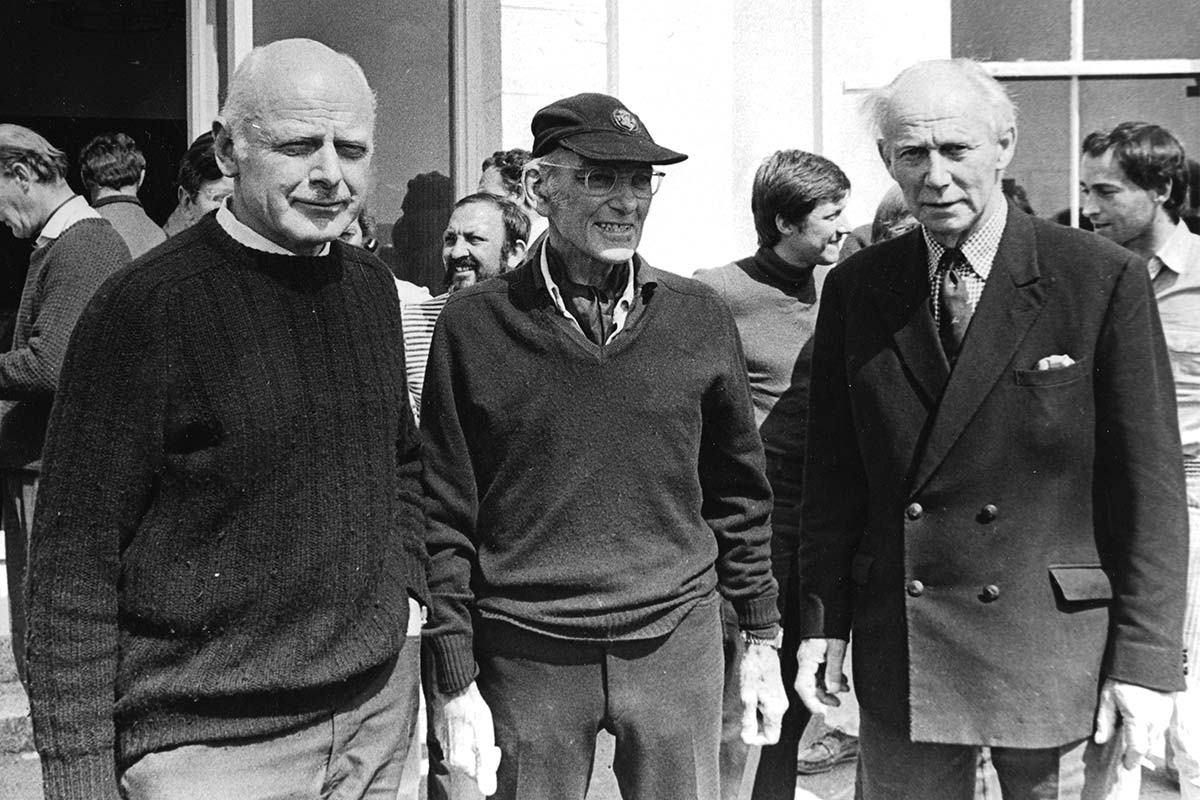
Commodore Chris Arscott is the only person in the 200 year history of the RWYC to have been Commodore twice, this time since 2019. Prior to this he has also held the position of Vice Commodore, Rear Commodore Sail and Cadet Principal.
He started sailing in the late 1960’s in Cadet dinghies and then went on to race at international level in the Hornet Class. He then graduated to racing J80’s where he won the French National Championships in the mid 1990’s. From there he moved on to racing an Archimbault A35, Water Jet, where he won the IRC National Championships and also qualified for the British Commodore’s Cup team. Consequently he was chosen as one of the selectors for the following year’s Commodore’s Cup.
Chris has two sons, Ben and James, both keen sailors. Ben was part of the British 420 National Squad where he won the World and National Under 17 titles.
Royal Western Yacht Club of England
Royal Western Yacht Club of England which is internationally known as one of the worlds premier yacht clubs and for its major contribution to the development of short handed ocean racing.
The Plymouth based Club is also recognized as one of the finest yacht clubs in the South of England providing the best possible facilities, overlooking Plymouth Sound, for all generations to enjoy both afloat and ashore.
Creation of OSTAR

In 1956 Blondie Hasler became interested in the challenges of offshore singlehanded sailing – “one man, one boat, the ocean…”. Over the next few years he conceived of a transatlantic race against the prevailing winds and currents whose purpose was to develop the necessary seamanship, equipment and techniques.
He had interested several competitors, but was unable to find an organiser or sponsor willing to move from the familiar full-crewed or ‘cruise in company’ racing to such a dangerous sounding innovation. His press release of November 1959 proclaimed “Described by one experienced yachtsman as ‘the most sporting event of the century’ a transatlantic race for single-handed sailing boats will start from the south coast of England on Saturday 11 June 1960 and will finish off Sheepshead Bay, in the approaches to New York, at least a month later”.
Blondie and Francis Chichester agreed that should no sponsor be found they would go ahead with the race anyway and each competitor would wager half-a-crown; winner take all. But Blondie persevered and, with Francis, approached the RWYC and got a positive response from the Rear Commodore Jack Odling-Smee.
With a yacht club of repute to take on the organisation of the race, Blondie obtained the sponsorship of The Observer newspaper and so the RWYC Singlehanded Trans-Atlantic Race for the Observer Trophy, or OSTAR, came about.
With sponsor and organiser in place, the half crown wager was no longer required but its proposal was recognised later when the Half Crown Club was created to honour the intrepid sailors who have competed in an OSTAR.
The Creation of the TWOSTAR

The Two-handed Transatlantic Race was created in response to the overwhelming success of the Singlehanded OSTAR. The Club had come under pressure around 1976 from “the authorities” to reduce the boat size and the number of boats in the OSTAR fleet.
However it was soon clear that the 1980 OSTAR would massively oversubscribed and that competitors were unhappy about the new boat length restrictions.
So in 1978 the decision was made to accommodate the overflow by running a second race in 1981. Because it was to be for boats sailed by a crew of two it could have more generous limits – 150 entries (100 for 1980 OSTAR) and boat lengths up to 85ft (56ft).
The event, which soon became known as the TwoSTAR, proved popular and it too was oversubscribed.
The Creation of the RB & I

Following the success of the first two OSTARs, Blondie Hasler proposed to the Royal Western Yacht Club that there should be a two-handed race around the British Isles. No doubt he considered a single-handed race, but the weather conditions and proximity to land necessitated two crew.
The Club considered the proposal and agreed to organise the first Round Britain and Ireland race in 1966. The course, of about 2000 miles, would be split into five legs separated by compulsory stop-overs of 48 hours each at Crosshaven in Ireland, Castle Bay, Barra in the Outer Hebrides, Lerwick in Shetland, and Harwich on the East Coast. It would circumnavigate Britain and Ireland and, with the exception of the Channel Islands and Rockall, all islands and rocks would be left to starboard.
The character of the event was set by the rule which said “The race is a sporting event to encourage the development of suitable boats, gear, supplies and techniques for efficient short-handed cruising under sail, and also to test the speed and seaworthiness of widely different types of boats by enabling them to race against each other on equal terms.”
Early critics argued that a race of this nature is no place in which to find out if a boat is seaworthy or not. But Blondie responded “The only reliable judge of seaworthiness is the sea itself, and the seaworthiness of an individual boat depends to a large extent on how she is handled. Many popular features in the design of modern racers would have been thought quite unseaworthy forty years ago. It is reasonable for inspection teams to reject anything that is in bad condition, but very difficult to reject a hull or rig as being inherently unseaworthy, particularly when the skipper is at least as experienced as the inspector. To exclude a boat on a questionable point of opinion is not usual in yacht racing but creates instant bad feeling and leaves the opinion unproven. To allow the sea to eliminate a design feature is fair, unanswerable, and a useful contribution to the science of seafaring. One of the main points of our two races is to allow experimenters a free rein and to learn something from the results.”
The first race was a great success with multihulls making their mark for the first time in oceanic racing by taking the first 6 places.
The RB&I was established on a four year cycle (two years off the OSTAR cycle). Lowestoft replaced Harwich as the east coast port from the second race on. Thereafter the course remained the same until Kinsale replaced Crosshaven in 2006.
The race grew rapidly to a multinational entry of many boat sizes and types. In 1982 the 85 starters included an 80ft monohull, a 70ft catamaran, several 60 and 65ft trimarans, down to a 25ft monohull, and represented over a dozen nationalities.
The following race was sailed in 1985, since 1986 was given over to the second TWOSTAR so it could run two years apart from the OSTAR. The four year cycle continued with races in 1989 and 1993. The 93 race was sponsored by the Teesside Development Corporation and saw Hartlepool replace Lowestoft as the East Coast stop-over. The RB&I reverted to its original schedule in 1998, returning to Lowestoft, then in 2006 Kinsale replaced Crosshaven as the Irish stopover port.
The Round Britain Race has certainly produced an amazing assortment of yachts. We have seen the 70 foot purpose-built racing yachts, both monohulled and multihulled, along with family cruising boats of all shapes and sizes. We have seen young, athletic crews sitting out on quarter-tonners for long periods while others have chosen to go round comfortably in a 47ft cruising boat with a junk rig which they could handle almost completely from inside.
Although the 48 hour stopovers are intended for rest, replenishment and repair, they are very much enjoyed as occasions for socializing. A tremendous spirit builds up amongst the crews of yachts of like speed as they meet each other in successive ports.
To add to the interest, various handicaping systems were devised but the important thing has always been the boat for boat competition. Handicapping was not universally approved of by the competitors and in one race the only entry on one, daily, page of a yacht’s log read “wind northerly (from ahead) force 9 – HOPE THE HANDICAPPER DROPS DEAD!” For a while handicapping was, as in the OSTAR, replaced by the sub-division of the fleet into a number of classes based on length in which the yachts race “boat for boat”, but now both use IRC and MOCRA for handicapping. However, the winner is still the first over the finish line in Plymouth and elapsed times are still used to recognise records by length.
Sail Sport Talk is an audio and multi-media broadcast on 10 platforms to 100 million people in 168 countries through Sports Byline USA. Tune in locations are here.
Sail Sport Talk with Karen Lile is aired inside the Rick Tittle Show every Tuesday morning Pacific Daylight Time at 9:37 sometimes beginning earlier with additional interviews. Rebroadcast happens at 15:37pm PDT and a Podcast is added on iheart radio. Tune in to Sail Sport Talk with Karen Lile on 10 different platforms during live experience.


